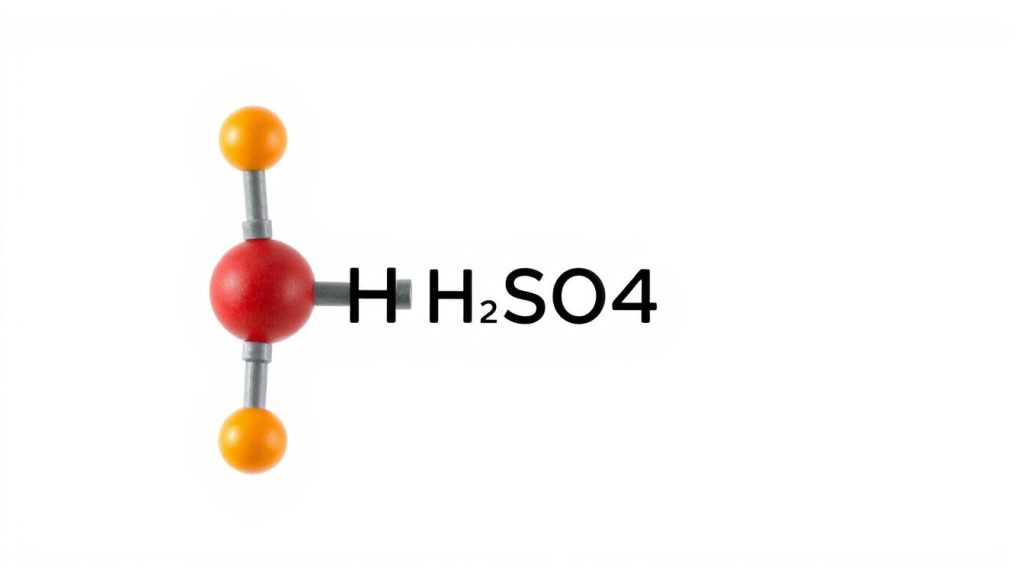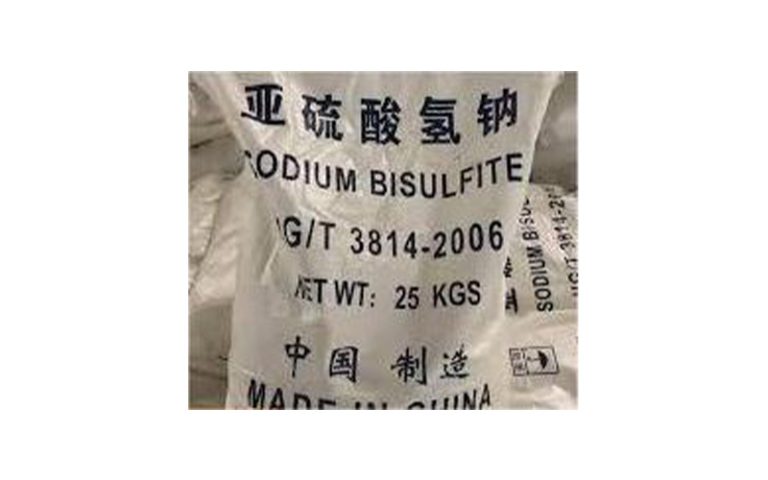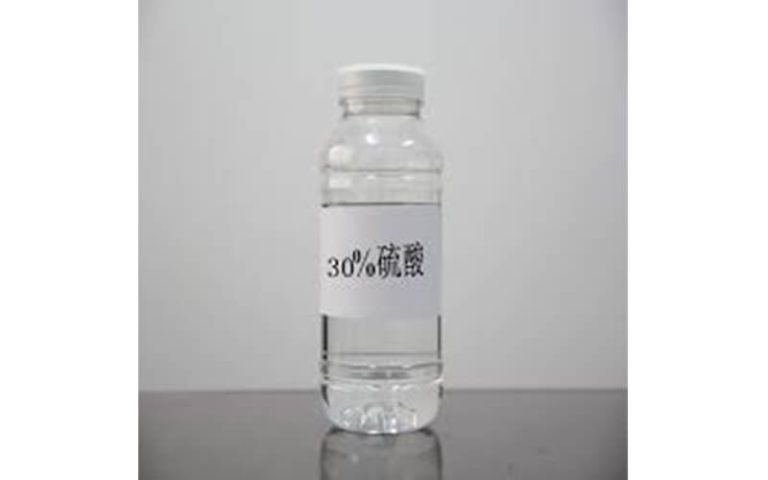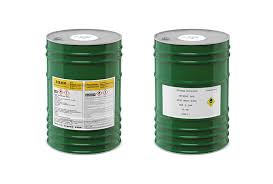Sulfuric Acid Formula: Understanding the H2SO4 Structure
Sulfuric acid formula, H2SO4, shows its molecular structure. Knowing this formula helps us understand its unique properties and uses.
The “H2” means it has two hydrogen atoms. The “S” is for one sulfur atom, and “O4” shows it has four oxygen atoms. This mix of elements makes sulfuric acid special and useful in many ways.

we see H2SO4 how the atoms are connected. This is key to understanding sulfuric acid’s chemical traits and uses.
Key Takeaways
- Sulfuric acid has the chemical formula H2SO4, which represents its molecular structure.
- The formula consists of two hydrogen atoms, one sulfur atom, and four oxygen atoms, arranged in a specific pattern.
- Understanding the sulfuric acid formula is crucial for comprehending the compound’s unique properties and diverse applications.
- The molecular composition of H2SO4 is essential for studying the chemical behavior and potential uses of this versatile substance.
- Analyzing the sulfuric acid formula provides insights into the compound’s characteristics and its role in various industries and scientific endeavors.
Introduction to Sulfuric Acid and Its Molecular Composition
Sulfuric acid, also known as H2SO4, is a versatile chemical used in many ways. This section will explore its basic traits, including its history and discovery.
Basic Properties and Chemical Identity
Sulfuric acid is a clear, odorless liquid at room temperature. Its formula, H2SO4, shows it has two hydrogen atoms, one sulfur atom, and four oxygen atoms.
Historical Discovery and Development
Sulfuric acid has been around since ancient times. But its modern use and production owe a lot to scientists and chemists.
In the 8th century, Jabir ibn Hayyan made sulfuric acid, called “oil of vitriol.” Later, Paracelsus in the 16th century improved its making and saw its uses.
The 19th century saw . The contact process by John Glover and the chamber process by Pierre Clément Arcet were key. These helped sulfuric acid become a vital chemical in our world.
PropertyValueMolecular FormulaH2SO4Molar Mass98.08 g/molAppearanceColorless, odorless liquidDensity1.84 g/cm³ (20 °C)Melting Point10.31 °CBoiling Point338 °C
Chemical Structure and Lewis Dot Representation of H2SO4
The chemical structure of sulfuric acid, or H2SO4, shows how atoms bond. The Lewis dot structure helps us see how electrons are shared. This is key to understanding the molecule.
The molecular geometry of H2SO4 is tetrahedral. The sulfur atom is at the center. Oxygen and hydrogen atoms are around it. This shape comes from the covalent bonds and the lone pairs on oxygen atoms.
ElementAtomic SymbolValence ElectronsHydrogenH1SulfurS6OxygenO6
The Lewis dot structure of H2SO4 shows how atoms and electrons are arranged. It helps us grasp the chemical properties and stability of sulfuric acid.
“The Lewis dot structure provides a powerful tool for visualizing the chemical bonding and electron arrangement in molecules, allowing us to better understand their properties and behaviors.”
Physical Properties and Characteristics of Sulfuric Acid
Sulfuric acid, with the chemical formula H2SO4, is a versatile and widely used chemical. Its physical properties and characteristics are key to understanding its behavior and uses. Let’s explore its density, boiling point, solubility, and appearance.
Density and Boiling Point
Sulfuric acid has a high density of about 1.84 g/cm³ at 25°C. This makes it one of the densest common laboratory acids. Its boiling point is around 337°C (639°F) at standard atmospheric pressure. This high boiling point comes from the strong hydrogen bonds between its molecules.
Solubility and Miscibility
Sulfuric acid is soluble in water, The solubility of sulfuric acid in water is virtually unlimited. This is because it can form strong hydrogen bonds with water molecules.
Physical Appearance and State
At room temperature, sulfuric acid looks like a clear, colorless, oily liquid. When concentrated, it might appear slightly yellow. This can change its physical state and properties.
PropertyValueDensity1.84 g/cm³ (at 25°C)Boiling Point337°C (639°F)Solubility in WaterHighly soluble, forming a miscible solutionPhysical AppearanceClear, colorless, and oily liquid (concentrated)
Knowing the physical properties and characteristics of sulfuric acid is vital for safe handling and use. Its high density, boiling point, and solubility make it versatile and widely used in many industries.
Chemical Bonding in H2SO4 Molecules
To grasp the special traits of sulfuric acid (H2SO4), we must look into its molecular structure. It’s made of sulfur, oxygen, and hydrogen atoms. The way these atoms bond is key to its properties.
The heart of the sulfuric acid molecule is covalent bonding. The sulfur atom links with two oxygen and two hydrogen atoms. This bonding makes the molecule stable and raises its boiling point.
But there’s more to sulfuric acid’s story. Intermolecular forces, like hydrogen bonding, also matter. The oxygen atoms in the molecule can bond with hydrogen atoms of other molecules. This creates a network of attractions. It’s why sulfuric acid dissolves well in water and is a strong acid.
The mix of covalent bonding and intermolecular forces, especially hydrogen bonding, defines sulfuric acid. It’s why this compound is so important and widely used in many fields.
sulfuric acid formulawhat is sodium chlorate
Understanding sulfuric acid’s formula and chemical makeup is key. It helps us grasp its role in different fields. We’ll explore its molecular weight and how it relates to sodium chlorate.
Understanding the Molecular Weight
The molecular weight of sulfuric acid, or H2SO4, is found by adding the atomic weights of its parts. Hydrogen (H) weighs 1.008 g/mol, sulfur (S) weighs 32.06 g/mol, and oxygen (O) weighs 16.00 g/mol.
Chemical Composition Breakdown
Sulfuric acid is made of:
- Hydrogen (H): 2 atoms, with a total weight of 2.016 g/mol
- Sulfur (S): 1 atom, with a weight of 32.06 g/mol
- Oxygen (O): 4 atoms, with a total weight of 64.00 g/mol
Sodium chlorate, or NaClO3, is related to sulfuric acid in some industrial uses. Its molecular weight is about 106.44 g/mol. It’s made of sodium (Na), chlorine (Cl), and oxygen (O).
CompoundMolecular FormulaMolecular Weight (g/mol)Sulfuric AcidH2SO498.08Sodium ChlorateNaClO3106.44
“The systematic understanding of sulfuric acid’s molecular weight and chemical composition is essential for its effective and safe application in various industries.”
Industrial Applications and Uses of H2SO4
Sulfuric acid, or H2SO4, is a key compound in many industries. It’s used in many ways, making it very important in chemical manufacturing and more.
In the fertilizer industry, sulfuric acid is a main ingredient. It helps make phosphate-based fertilizers, which make soil better for growing crops. It’s also used in metal processing for things like metal pickling and making titanium dioxide, a common pigment.
Industrial UseDescriptionFertilizer ProductionSulfuric acid is a crucial component in the manufacturing of phosphate-based fertilizers, which are vital for improving soil fertility and crop yields.
Metal ProcessingSulfuric acid is used in metal pickling, electroplating, and the production of titanium dioxide, a widely used pigment.Battery AcidThe high concentration of sulfuric acid in battery acid makes it an essential ingredient in the production of lead-acid batteries, which are commonly used in automobiles and other devices.Chemical ManufacturingSulfuric acid is a key reagent in the synthesis of various chemicals, including detergents, explosives, and dyes.
Sulfuric acid is also key in making battery acid. This acid is vital for making lead-acid batteries, used in cars and other devices.
This includes detergents, explosives, and dyes.
It’s used in making fertilizers, processing metals, and making batteries. This shows how important it is for the economy.
Protective Equipment Requirements
When dealing with sulfuric acid, wearing the right gear is key. This includes:
- Chemical-resistant gloves
- Face shield or safety goggles
- Acid-resistant apron or coveralls
- Closed-toe shoes or boots
Emergency Response Protocols
Quick action is vital in case of spills or exposure. Here’s what to do:
- Clear the area and keep it off-limits.
- Turn on the emergency shower and eye wash if you have them.
- Call the right people and emergency teams.
- Give first aid, focusing on flushing with lots of water.
- Use absorbents to stop the spill from spreading.
Storage Guidelines
Storing sulfuric acid safely is key to avoiding accidents. Follow these steps:
RequirementGuidelineStorage LocationKeep it in a cool, dry, and well-ventilated spot, away from dangerous materials.Container TypeUse containers that can handle acid, like polyethylene or stainless steel.LabelingMake sure all containers are clearly labeled with what’s inside and any hazards.Spill ContainmentMake sure the storage area has the right spill containment measures.
By following these safety steps and handling procedures, you can reduce risks with sulfuric acid. This helps keep your work area safe.
Environmental Impact and Regulations
The use of sulfuric acid affects our environment, especially in creating acid rain. It can harm ecosystems, buildings, and our health when it gets out.
When it mixes with water vapor, it forms droplets that fall as acid rain. This rain can kill plants, pollute water, and damage buildings.
To lessen the harm of sulfuric acid, many environmental regulations have been made. These rules aim to control pollution. They require industries to use scrubbers and other tech to cut down emissions.
RegulationDescriptionClean Air Act (USA)Limits the amount of sulfur dioxide and other air pollutants that can be emitted by industrial facilities, helping to reduce acid rain formation.EU Industrial Emissions DirectiveRequires industrial plants to obtain permits and implement best available techniques to minimize the environmental impact of their operations, including the handling of sulfuric acid.Minamata Convention on MercuryAddresses the global issue of mercury pollution, which can be released during the production and use of sulfuric acid.
By following these environmental regulations and using pollution control methods, industries can reduce harm. This helps protect our environment and health.
A landscape soaked in acid rain, with dark clouds looming overhead, raindrops splashing on wilted plants and corroded buildings, a city skyline in the background, muted colors reflecting the environmental damage, puddles of water showing chemical reactions, a sense of desolation and despair.
“Protecting the environment is not just a moral obligation, but a necessity for our long-term survival. Responsible management of chemicals like sulfuric acid is crucial in this endeavor.”
Production Methods and Manufacturing Process
Sulfuric acid is key in many industrial processes. It’s made through the Contact Process and the Chamber Process. These methods have improved over time to meet the demand for sulfuric acid.
Contact Process
The Contact Process is the main way to make sulfuric acid on a large scale. It uses chemical reactions to turn sulfur dioxide (SO2) into sulfur trioxide (SO3). Then, SO3 is mixed with water to create concentrated sulfuric acid (H2SO4).
- Oxidation of sulfur dioxide (SO2) to sulfur trioxide (SO3) using a catalyst, typically vanadium pentoxide (V2O5).
- Absorption of the produced sulfur trioxide (SO3) in water, forming sulfuric acid (H2SO4).
- Concentration of the sulfuric acid solution to the desired strength, typically 98% or higher.
Chamber Process
The Chamber Process is an older way to make sulfuric acid. It directly mixes sulfur dioxide (SO2) with oxygen (O2) and water vapor. This creates sulfuric acid (H2SO4) in lead-lined chambers.
- Combustion of sulfur to produce sulfur dioxide (SO2).
- Oxidation of sulfur dioxide (SO2) to sulfur trioxide (SO3) using air and water vapor.
- Absorption of the sulfur trioxide (SO3) in water, forming sulfuric acid (H2SO4).
- Concentration of the resulting sulfuric acid solution.
- ProcessAdvantagesDisadvantagesContact ProcessHigher efficiency and productivity
- Produces more concentrated sulfuric acid
- Requires less energy input
- Requires more specialized equipment and catalysts
- Higher initial investment costs
- Chamber ProcessSimpler and more basic design
- Lower initial investment costs
- Lower efficiency and productivity
- Produces less concentrated sulfuric acid
- Requires more energy input
Both the Contact Process and the Chamber Process are vital in making sulfuric acid. They help meet the needs of the sulfuric acid production, industrial synthesis, and chemical manufacturing industries.
Common Reactions and Chemical Behavior
Sulfuric acid, H2SO4, is known for its wide range of chemical reactions. It’s used in many ways because of its versatility. Let’s look at some common reactions and its key characteristics.
Acid-Base Reactions
Sulfuric acid is a strong acid that easily reacts with bases. It gives up protons (H+) to bases, creating salts and water. For instance, when mixed with sodium hydroxide (NaOH), it makes sodium sulfate (Na2SO4) and water:
H2SO4 + 2NaOH → Na2SO4 + 2H2O
Oxidizing Agent
Sulfuric acid is also an oxidizing agent. It can accept electrons and oxidize other substances. This is why it’s useful in making fertilizers and treating metal surfaces.
Dehydration Reactions
Sulfuric acid loves water molecules, making it a dehydrating agent. It can remove water from organic compounds, creating new products. This is seen in the dehydration of sugars and making charcoal from wood.
Reaction TypeExampleAcid-Base ReactionH2SO4 + 2NaOH → Na2SO4 + 2H2OOxidation2Fe + 3H2SO4 → Fe2(SO4)3 + 3H2DehydrationC12H22O11 (sucrose) + H2SO4 → 12C (charcoal) + 11H2O
It’s used in many industries, from making fertilizers to processing metals.
Conclusion
In this detailed article, we’ve looked at sulfuric acid, a key industrial chemical. We’ve covered its molecular makeup, chemical structure, and many uses.
Sulfuric acid, or H2SO4, is crucial in many areas like fertilizer making and energy storage. As we look ahead, scientists are finding new ways to use sulfuric acid, showing its endless potential.
In summary, sulfuric acid shows the impact of chemistry on our lives. Its ongoing importance and new uses show why we need to understand it well.
yuhan Sodium Chlorate:https://www.yuhanchemi.com/sodium-chlorate
We support product customization Specific specifications, grades, reagents, price comparison is welcome
Contact us:https://www.yuhanchemi.com/contact







